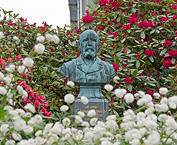Discoverer of the leprosy bacillus
Gerhard Armauer Hansen (1841-1912) is the most famous Norwegian doctor through time. His discovery of the leprosy bacillus in 1873 was not only a breakthrough in leprosy work, it was also the first case where it was proved that a microorganism could cause chronic disease in humans.

Main content
Armauer Hansen was a doctor at the Care Trust and St. Jørgens Hospital in Bergen from 1868. He was a member of the board of the Bergen Museum for many years, and the president there from 1894. In 1892 he was appointed officer of St. Olav, in 1901 he received the Commander’s Cross, and in 1909 he became Grand Officer of the Order. In 1909 he was the honorary president of the International Congress on Leprosy, held in Bergen. His bust was unveiled in the park at the Bergen Museum in 1901, and is still there today.
Armauer Hansen’s head and shoulders are depicted in bronze, life-size. Deep-seated eyes and a long mustache make him seem serious and a little sad. This was a man who saw and experienced a lot - leprosy is a terrible disease. Visdal has taken steps to ease the impression of melancholy by giving Armauer Hansen an erect, noble attitude.
Jo Visdal (1861-1923) was one of the most productive sculptors of his time. He focused particularly on portrait busts and reliefs in a sober, realistic style. Especially well known are his depictions of Edvard Munch and Knud Knudsen. He made few sculptures in larger format, but the full-length statue of Carsten Anker at the Eidsvoll building is worth mentioning. Visdal was responsible for the portrait of King Haakon VII that adorned the Norwegian coins minted in 1907.
NORA SØRENSEN VAAGE
